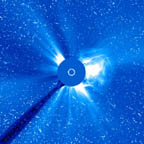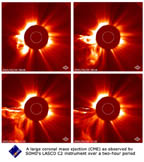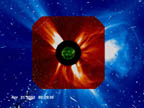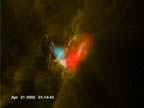June 18, 2003 - (date of web publication)
Spacecraft Trio Peeks at Secret Recipe for Stormy Solar Weather
Image 1
The Sun is a mighty chef. It stirs sunspots, boils electrified gasses, then serves up the main course - violent solar weather in the form of a coronal mass ejection (CME) with a side of solar flare. Like superstar chefs everywhere, the Sun carefully guards its recipes. However, three spacecraft - RHESSI, SOHO and TRACE - have worked in collaboration to record for the first time the entire initiation process of a high-speed CME, providing clues about the Sun's secret recipe for stormy weather and ultimately helping scientists understand turbulent solar activity and its effects on Earth.
Image 2
CMEs are billion-ton eruptions of electrically charged gas (plasma) in the Sun's atmosphere (corona). The fastest CMEs are blasted into space at a speed of up to five million miles per hour (eight million km/hr.). CMEs are often associated with solar flares. A flare is a giant explosion in the solar atmosphere that spews radiation and results in the heating of solar gas and the acceleration of particles to nearly the speed of light. Both events can be initiated in a matter of seconds, making their joint observations difficult to coordinate.
Image 3
The three spacecraft involved were NASA's Reuven Ramaty High Energy Solar Spectroscopic Imager (RHESSI), which takes pictures of flaring regions on the Sun using the Sun's high-energy X-rays and gamma rays; NASA's Transition Region and Coronal Explorer (TRACE), which makes images using ultraviolet light from the Sun; and the Solar and Heliospheric Observatory (SOHO) spacecraft, a collaboration between NASA and the European Space Agency.
Image 4
"This was the first time that we have been able to identify and study in detail the region on the Sun where the initiation and acceleration of a coronal mass ejection occurs," said Dr. Peter Gallagher, research scientist for RHESSI and SOHO at NASA's Goddard Space Flight Center, Greenbelt, Md., and lead author of two papers on this research. "We now have a better understanding of how the energy release above the surface of the Sun relates to the ejection of material, perhaps allowing some real-time forecasts."
If a CME is directed towards Earth, it can shut down electrical systems and disrupt signals from satellites and aircraft when it hits the magnetic field surrounding our planet. Understanding how the Sun "heats and serves" a CME and knowing what type of energy to look for prior to one will help scientists predict when a CME will occur so they can issue warnings.
The twisting and snapping of magnetic field lines on the Sun, called magnetic reconnection, seem to cause CMEs and solar flares, among other solar events. When these fields snap from the buildup of magnetic energy, plasma is heated and particles are accelerated, resulting in massive explosions and emitting radiation ranging from radio waves to X-rays and gamma rays. Frequently, a CME and flare will burst from the same region of the Sun nearly simultaneously. Just like the debate over whether the chicken or the egg came first, solar researchers discuss whether flares cause CMEs or the reverse, or if they are more loosely associated.
The April 21, 2002 observation confirmed the predominant scenario for high-speed CMEs (those moving at one million to 5 million miles per hour or 1.6 million to 8 million km/hr.). This is where solar magnetic fields act like a lid, holding down a blob of gas (CME) that is trying to rise. Somehow, the magnetic lid opens, possibly as a result of magnetic reconnection and the generation of a flare, and then the CME rises from the Sun, dragging the magnetic fields with it. Magnetic reconnection continues to energize the associated flare for over 12 hours.
All three spacecraft played vital roles in confirming that this was the process. First, RHESSI saw a gradually increasing burst of X-rays announcing the start of the flare. TRACE observed the CME in the extreme ultraviolet as it began to rise from the Sun. Several minutes later, RHESSI saw a burst of high energy X-rays under the erupting CME, and TRACE saw a similar explosion of ultraviolet rays, both indicating a large flare. SOHO then captured the CME as it continued moving away from the Sun.
"Each of these spacecraft is quite complementary," said Gallagher. "It's only through their coordination in this observation that we're now able to understand the predominant scenario for these fast, large coronal mass ejections and the associated flares."
The current results feed into the decades-old controversy over whether solar flares cause coronal mass ejections, or vice versa. While the first signs of the flare occur before the CME liftoff, the bulk of the flare energy is released later, after the CME has already been accelerated. The two phenomena are revealed to be merely different aspects of the same event, according to the team.
For movies and more images, refer to:
http://hesperia.gsfc.nasa.gov/hessi/
MEDIA CONTACTS:
For more information, contact:
Lindsay Renick Mayer
Goddard Space Flight Center
Greenbelt, Md.
(Phone: 301 286 7646)
Bill Steigerwald
Goddard Space Flight Center
Greenbelt, Md.
(Phone: 301 286 5017)
NASA's Sun-Earth Connection Program
High-resolution images:
(3 MEG TIF image)
Caption:
This is a picture of the CME associated with the April 21, 2002 flare taken by the Large Angle and Spectrometric Coronagraph (LASCO) instrument on board SOHO. The image is in false color; the white areas are concentrations of electrified gas in the Sun's atmosphere. The CME is the large, wispy white cloud seen to the right of the blue disk. The disk is a device that blocks direct sunlight so the much fainter solar atmosphere can be seen. The white ring inside the disk represents the size of the Sun. White dots in the image result when accelerated particles from the flare and CME hit the image sensor in LASCO.
CREDIT: NASA/ESA
(6 MEG TIF image)
Caption:
CME observed by LASCO C2 --A false-color image sequence over two hours of a large coronal mass ejection 20 March 2000 taken by the LASCO C2 instrument. In this sequence a CME blasts into space a billion tons of particles traveling millions of miles an hour. This CME was not headed towards Earth, though the ones that are can cause problems with satellites, communications, and power equipment when the CME hits the Earth's magnetic field.
CREDIT: NASA/ESA
(14.7 MEG TIF image)
Caption:
The April 21, 2002 CME observed by several instruments onboard the SOHO spacecraft. The green image shows the Sun's inner atmosphere or corona, from which the CME emerged. The later stages of the expanding CME are visible in the red and blue colored images taken with LASCO. The CME is the large, wispy white cloud seen to the right of the red and blue images. White dots in the image result from particles from the flare hitting the cameras of the LASCO instrument.
CREDIT: NASA/ESA
(14.7 MEG TIF image)
Caption:
This is a composite picture of a large solar flare which occurred on April 21, 2002 taken with the RHESSI and TRACE satellites. The TRACE picture, in brown, shows the hot million-degree gas close to the Sun's surface. The red and white blobs show the high energy X-rays observed by RHESSI. This is the first time such high quality X-ray pictures have been obtained, and provide solar physicists with a new understanding of how solar flares and coronal mass ejections (CMEs) are related.
CREDIT: NASA/ESA



